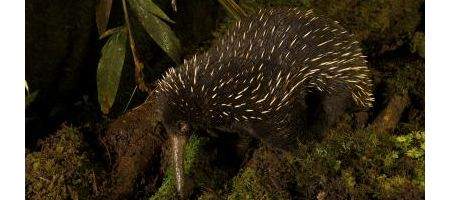The western long-beaked echidna, believed to have become extinct in Australia thousands of years ago, may still be alive and kicking in parts of the country today.

Like the platypus, echidnas are monotremes – a small and primitive order of mammals that lay eggs rather than give birth to live young. And, like the platypus, the long-beaked echidna is very odd in appearance: beach-ball sized, and covered in coarse blackish-brown hair and spines. It has a long, tubular snout, and a female lays a single leathery egg directly into their pouch where it hatches in about 10 days.
Until now, the long-beaked echidna has been believed to be restricted to a small and declining population on the Indonesian portion of New Guinea.
“The discovery of the western long-beaked echidna in Australia is astonishing,” says Professor Tim Flannery of Macquarie University.
Fossil remains from the Pleistocene epoch, along with ancient Aboriginal rock art, show that it did occur in Australia tens of thousands of years ago. However, no modern record from Australia was known to exist until now, when scientists discovered aspecimen at the Natural History Museum in London – collected in northwestern Australia in 1901.
“Sometimes while working in museums, I find specimens that turn out to be previously undocumented species,” says Kristofer Helgen of the Smithsonian Institution. “But in many ways, finding a specimen like this, of such an iconic animal, with such clear documentation from such an unexpected place, is even more exciting.”
The re-examined specimen in London reveals that the species was reproducing in Australia at least until the early 20th century.
“The next step will be an expedition to search for this animal. We’ll need to look carefully in the right habitats to determine where it held on, and for how long, and if any are still out there. We believe there may be memories of this animal among Aboriginal communities, and we’d like to learn as much about that as we can,” says Helgen.
“We hold out hope that somewhere in Australia, long-beaked echidnas still lay their eggs.”






